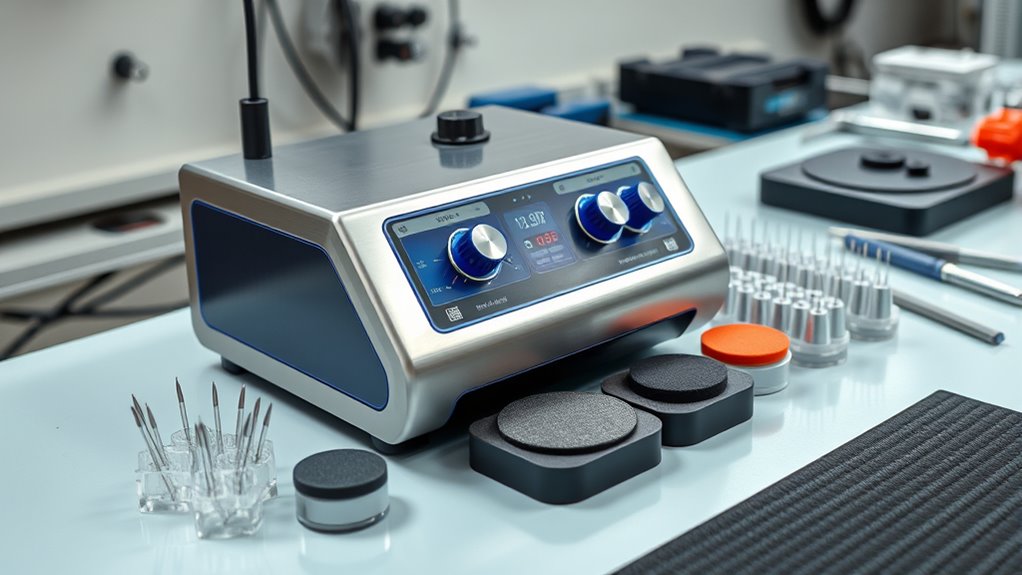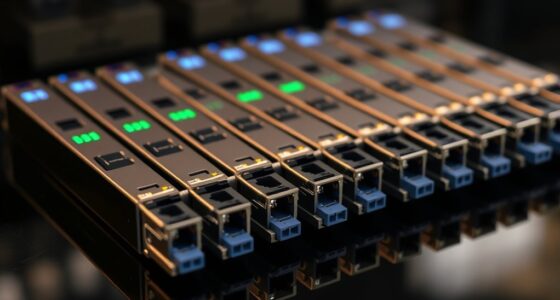If you’re looking for the 14 best fiber optic polishing machines for 2025, I recommend models that offer versatility, precision, and durability. Features like adjustable speeds, compatibility with various connector types, and portable designs are essential. High-quality construction with easy maintenance guarantees longevity, while precise control helps achieve perfect finishes. Whether you prefer manual, electric, or cordless options, there’s a machine for your needs. Keep exploring to find the perfect fit for your fiber optic projects.
Key Takeaways
- Compatibility with multiple connector types and ferrule sizes ensures versatile applications for various fiber optic polishing needs.
- Adjustable polishing speeds (1,750 to 8,500 RPM) and interchangeable parts deliver precise control and high-quality results.
- Durable construction with high-quality materials guarantees longevity and reliable performance in demanding environments.
- Portable, lightweight designs with compact footprints facilitate easy transport and quick setup in field or workshop settings.
- User-friendly features like digital displays, easy maintenance, and modular components enhance efficiency and ease of operation.
Maxshine M15 Pro Dual Action Polisher
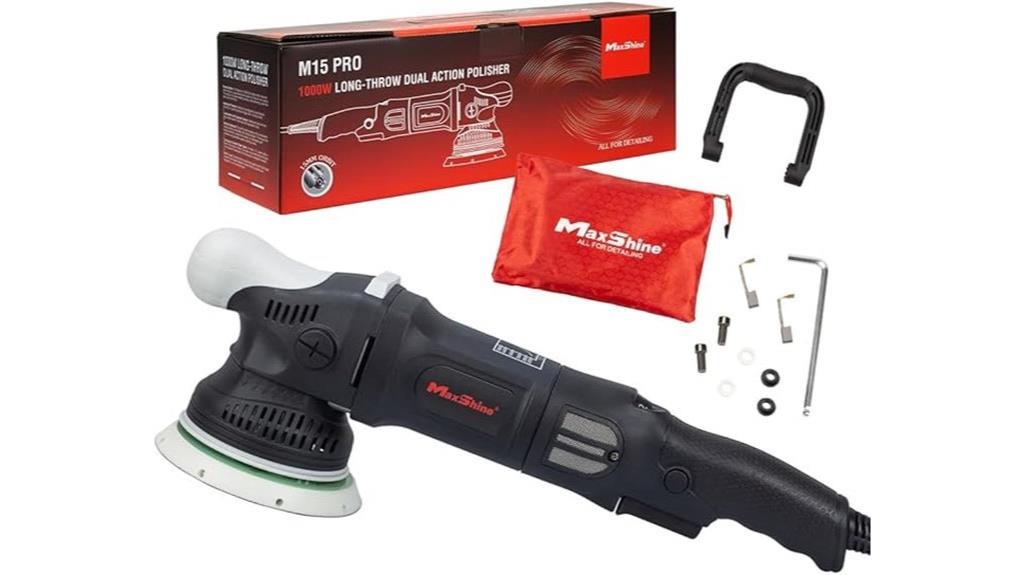
The Maxshine M15 Pro Dual Action Polisher is an excellent choice for professional detailers and serious enthusiasts who need fast, swirl-free results. Its 15mm orbital throw covers more surface area, speeding up the polishing process while maintaining a flawless finish. Powered by a robust 1000W motor, it offers strong, reliable torque for removing scratches and restoring gloss. Designed for comfort, it features an ergonomic rubberized grip and D-handle, reducing fatigue during long sessions. Its lightweight build and balanced design ensure easy handling on large surfaces. With a versatile 5-inch backing plate and a long 13-foot cord, it adapts perfectly to various tasks and workspace setups.
Best For: professional detailers and serious enthusiasts seeking fast, swirl-free paint correction with professional-grade results.
Pros:
- 15mm orbital throw for broader surface coverage and faster polishing.
- 1000W motor delivers strong, reliable torque for effective scratch removal.
- Ergonomic design with rubberized grip and D-handle reduces fatigue during extended use.
Cons:
- May be heavier than smaller, less powerful polishers, potentially tiring for prolonged use.
- Requires compatible pads and accessories, which may involve additional purchase.
- Might be overpowered for very delicate or small surfaces, risking damage if not used carefully.
Jewelry Polisher with Accessories
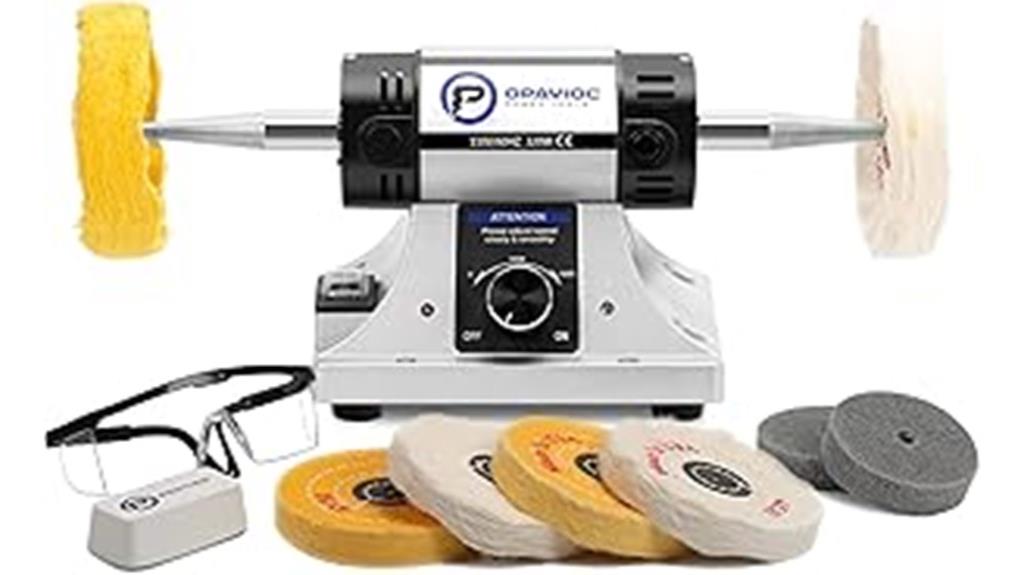
If you’re looking for a versatile jewelry polisher that combines power with precision, this machine is an excellent choice. With an adjustable 320W motor, it offers speeds from 1750RPM to 8500RPM, making it suitable for polishing, buffing, and grinding various materials. Its compact and lightweight design guarantees portability for workshops or DIY setups. The included accessories—six cotton cloth wheels, two abrasive fiber wheels, and polishing compounds—expand its capabilities, whether working on jewelry, gems, or even cleaning tasks. The adjustable speed allows for delicate finishes or heavy-duty work, making it a flexible tool for professionals and hobbyists alike.
Best For: Jewelry makers, watchmakers, dental professionals, and DIY enthusiasts seeking a versatile and portable polishing and grinding solution.
Pros:
- Adjustable speed from 1750RPM to 8500RPM for precise control across various tasks
- Compact, lightweight design for easy portability and space-saving setup
- Includes multiple accessories such as cotton cloth wheels, fiber wheels, and polishing compounds for diverse applications
Cons:
- Limited to 320W power, which may not be suitable for very heavy-duty grinding tasks
- Small size might require careful handling to avoid vibration or instability during use
- May require additional accessories or attachments for specialized applications beyond polishing and buffing
18V Cordless Car Polisher with 15MM Orbital and 5/6 Buffing Pads

For anyone seeking a portable and efficient polishing tool, the V Cordless Car Polisher with 15mm orbital and 5/6 buffing pads stands out. Its brushless DC motor delivers high torque, long battery life, and durability, making it ideal for extended use. The 18V cordless design offers excellent mobility, allowing me to work freely without cords snagging. The 15mm orbital size ensures smooth, effective polishing, while the included 5/6 buffing pads handle various surfaces with ease. Its balanced battery placement, CNC eccentricity, and compact build provide stability and comfort. Overall, this polisher combines power, precision, and convenience for automotive polishing tasks.
Best For: individuals seeking a portable, high-performance polishing tool for automotive and surface finishing tasks with ease and precision.
Pros:
- High torque and durability thanks to the brushless DC motor.
- Cordless 18V design offers excellent mobility and convenience.
- Smooth and effective polishing with 15mm orbital size and versatile buffing pads.
Cons:
- Battery life may be limited during extended use without additional packs.
- Slightly heavier weight due to balanced battery placement for prolonged handling.
- Requires compatible battery packs, which may need separate purchasing or replacement.
Maxshine Mini Cordless Polisher Kit (M0312 V2 BK) – Portable 6-Speed Auto Detailing Polisher
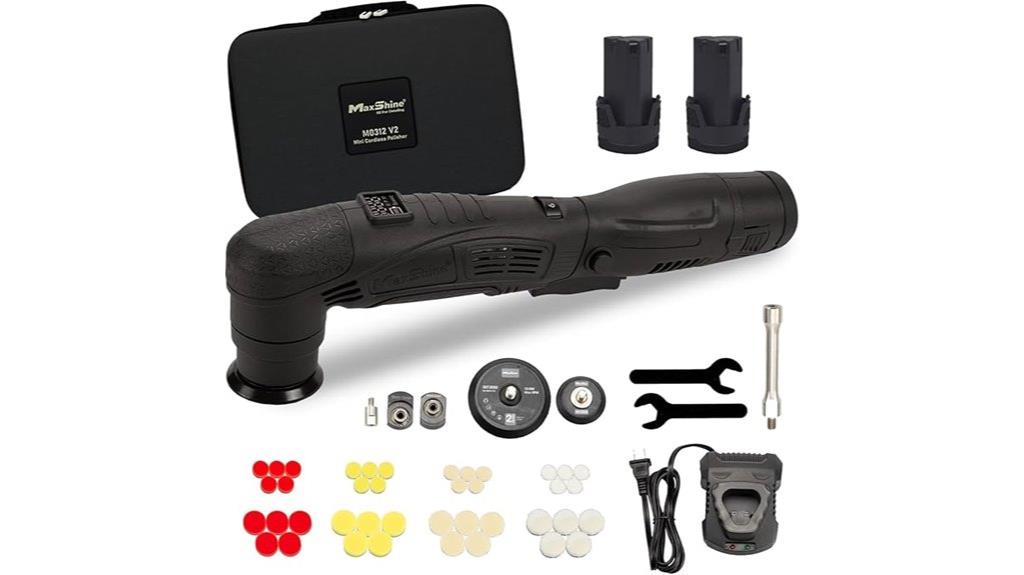
Designed for auto detailers who need precision and portability, the Maxshine Mini Cordless Polisher Kit (M0312 V2 BK) stands out with its lightweight build and versatile speed control. Weighing only 2.11 pounds with the battery, it’s easy to maneuver around intricate surfaces and contours, reducing fatigue during extended use. Its six adjustable speeds—from 2500 to 6000 RPM—allow me to tailor the polishing intensity exactly. The upgraded battery offers 35-45 minutes of runtime and quick recharging, while the ergonomic grip and anti-slip switch ensure comfort and control. This compact tool simplifies scratch removal, swirl correction, and paint finishing with professional results.
Best For: auto detailers and enthusiasts seeking a lightweight, portable, and versatile polisher for precision scratch removal, swirl correction, and paint finishing.
Pros:
- Lightweight and ergonomic design for easy maneuverability and reduced user fatigue
- Adjustable 6-speed settings for customized polishing performance
- Quick recharge time with long battery life of 35-45 minutes per charge
Cons:
- Limited runtime may require multiple batteries for extended projects
- Slightly higher price point compared to basic corded polishers
- Battery indicator may not provide detailed remaining time, requiring attention to charge levels
2pcs Fiber Optic Cleaner Pen
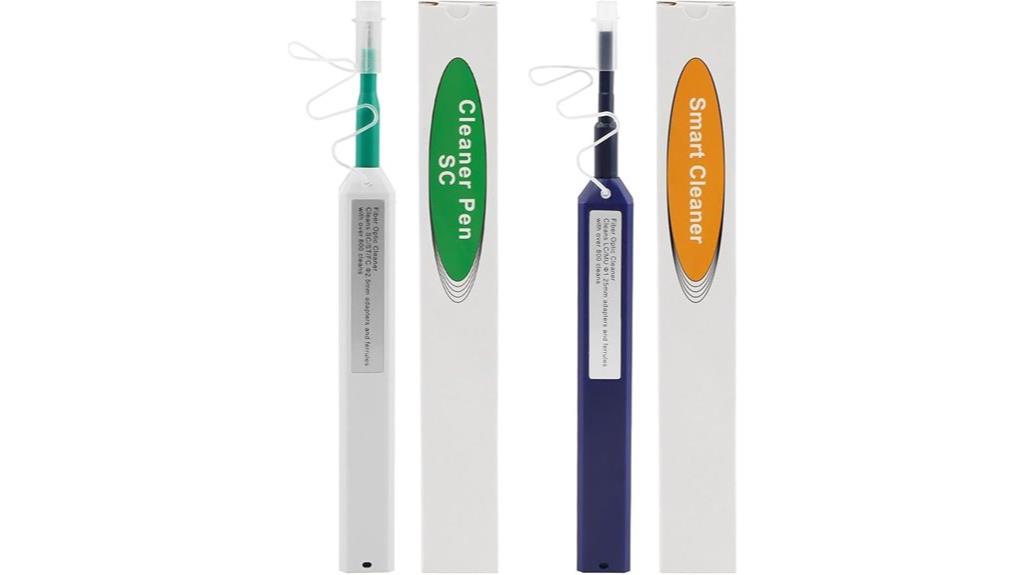
The pcs Fiber Optic Cleaner Pen stands out as an essential tool for technicians and enthusiasts who need quick, reliable cleaning of fiber connectors. It comes with two pens: blue for 1.25mm LC connectors and white for 2.5mm SC, FC, and STE2000 connectors. Its compact, durable design features a 180-degree rotary mechanism and a prompt sound to signal cleaning completion. Capable of over 800 uses, it delivers up to 99% cleaning efficiency, removing dirt and contaminants effectively. Easy to operate with a clear window revealing the microfiber reel, it’s perfect for both fieldwork and maintenance in various settings.
Best For: technicians, network installers, and fiber optic enthusiasts seeking quick, reliable cleaning tools for various fiber connector types.
Pros:
- Reusable for over 800 cleaning cycles, offering excellent value.
- Compatible with multiple connector sizes (1.25mm LC and 2.5mm SC/FC/STE2000), ensuring versatility.
- Compact and durable design with anti-static resin construction makes it suitable for field and indoor use.
Cons:
- Requires manual operation, which may be less convenient compared to battery-powered options.
- Limited to cleaning fiber connector end faces; not suitable for other fiber optic components.
- May be less effective on heavily contaminated connectors without additional cleaning methods.
Fiber Visual Fault Locator 50KM with FC/LC Adapter Kit
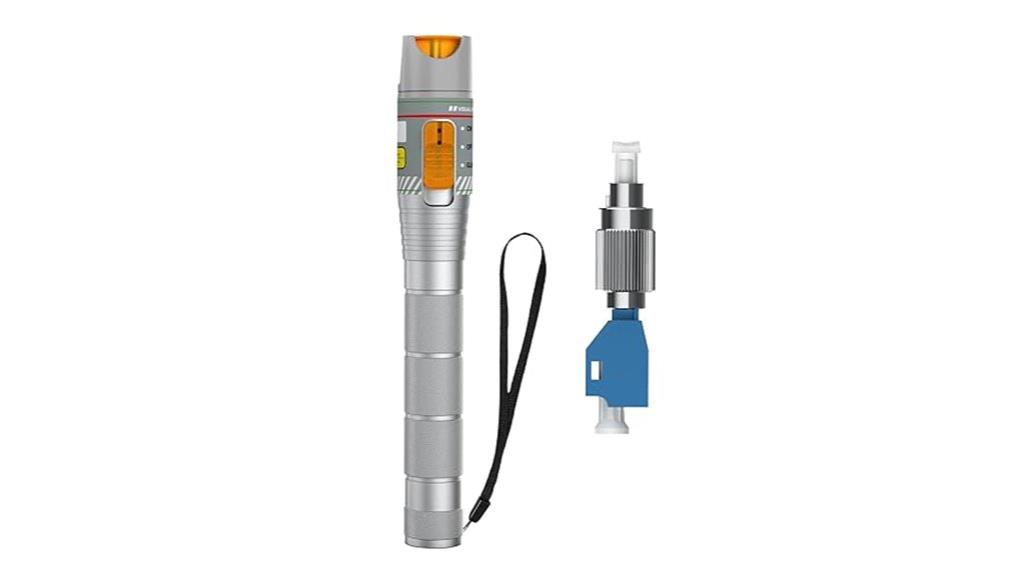
If you’re working in telecommunications, CATV, or engineering fields, the Fiber Visual Fault Locator 50KM with FC/LC Adapter Kit stands out as an essential tool for identifying fiber faults quickly and accurately. It emits a 650nm red light to detect fractures, bad connections, bends, or openings, creating a bright glow for easy fault pinpointing. With a range of up to 50 km, it supports both single-mode and multi-mode fibers in continuous wave and pulse modes. Compact and lightweight, it’s perfect for field use, with sturdy construction, universal connectors, and helpful accessories like adapters, a carrying bag, and a lanyard.
Best For: technicians and engineers performing fiber optic testing, fault detection, and maintenance in telecommunications, CATV, and engineering applications.
Pros:
- Bright 650nm laser for clear fault visualization over long distances up to 50 km
- Compact, lightweight, and portable design ideal for field use
- Supports multiple connector types and both continuous wave and pulse modes for versatile testing
Cons:
- Battery leakage and durability issues reported after prolonged use; requires high-quality batteries
- Some units may not fit all connector types perfectly, especially LC connectors without additional adapters
- Laser exposure risk if directed into eyes; safety precautions necessary during operation
TECHTONGDA Digital Fiber Polisher
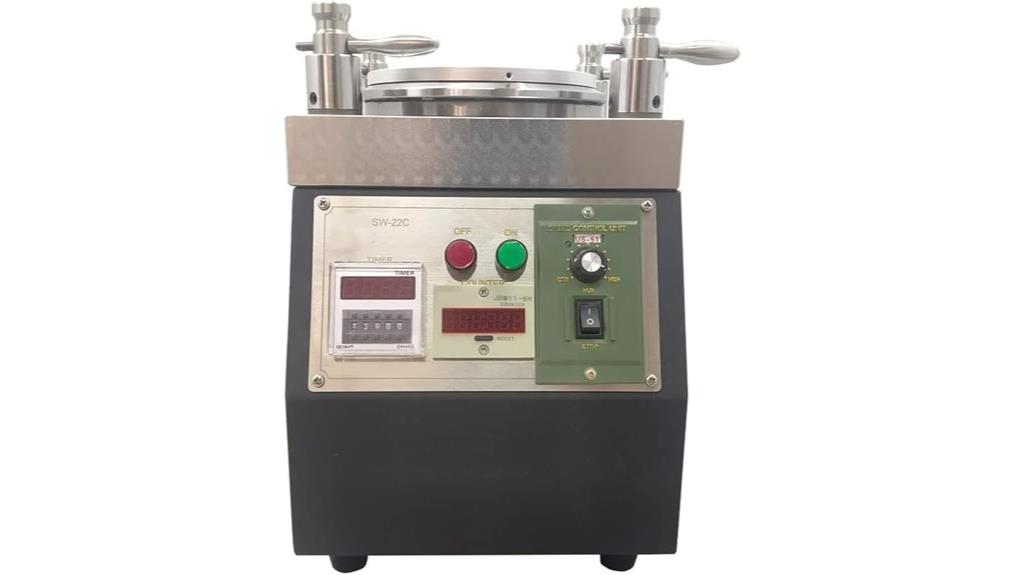
For those seeking high-precision fiber polishing, the TECHTONGDA Digital Fiber Polisher stands out with its planetary track grinding method, which allows for adjustable speeds and consistent results. Its compact, lightweight design makes it easy to operate and ideal for space-constrained environments. Built from durable 316 die steel, it offers high accuracy and long-lasting performance. With compatibility for various grinding fixtures, each disc can handle 10-40 heads, supporting large-scale processing. Its versatile range allows grinding of ceramic ferrules, quartz, glass, and even metals like stainless steel and titanium. Overall, it’s a reliable choice for efficient, industrial-grade fiber polishing.
Best For: professionals and industries requiring high-precision, large-scale fiber polishing across various materials such as ceramics, glass, and metals.
Pros:
- Adjustable planetary track grinding method for precise speed control
- Compact, lightweight design ideal for space-limited environments
- Durable construction from high-quality 316 die steel ensures long-lasting performance
Cons:
- May require training for optimal operation due to its advanced features
- Limited to compatible grinding fixtures, which might necessitate additional accessories
- Power supply is 110V, so may need voltage adaptation in some regions
Fiber Optic Cleaning Box with SC and LC Cleaners
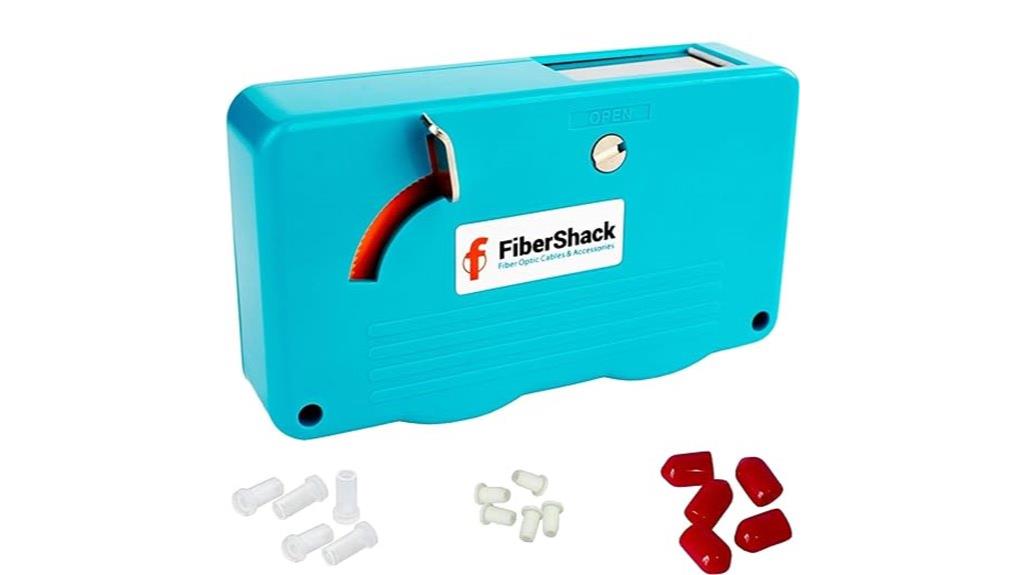
Designed for industry professionals, the Fiber Optic Cleaning Box with SC and LC cleaners offers a versatile and reliable solution for maintaining fiber optic connectors. It includes 2.5mm SC and 1.25mm LC cleaners, capable of over 500 uses, fitting various connector types like SC, LC, FC, ST, and APC. Its compact, lightweight design allows quick, solvent-free cleaning, leaving no lint or residue for professional results. The hybrid fabric guarantees thorough cleaning, while the included leather case protects the tool during fieldwork. Trusted across the USA, this durable, industry-proven device is essential for efficient fiber optic maintenance and installation.
Best For: industry professionals and fiber optic technicians seeking a reliable, versatile cleaning tool for maintaining a variety of fiber connector types in field and installation scenarios.
Pros:
- Reusable for over 500 cleanings, offering cost efficiency and durability
- Compact, lightweight design for easy handling and portable use in the field
- No alcohol or solvents needed, providing a quick and residue-free cleaning process
Cons:
- May require careful handling to prevent fabric wear over extensive use
- Limited to cleaning fiber connectors and not suitable for other cleaning tasks
- Leather case, while protective, adds extra bulk for very tight storage situations
Optical Fiber Grinding Machine

The Optical Fiber Grinding Machine stands out with its high-precision construction using durable 316 die steel, making it ideal for professionals seeking reliable, large-scale fiber optic processing. Its heat-treated design guarantees longevity and accuracy across various materials like ceramic ferrules, quartz, glass, stainless steel, titanium alloys, and resin. The planetary track grinding method, combined with adjustable speeds, allows customization for different materials and applications. Supporting 10-40 grinding heads per disc, it offers impressive efficiency. Its compact, lightweight, and low-noise design makes it easy to operate and suitable for diverse work environments, maximizing productivity and precision in fiber optic manufacturing.
Best For: professionals and manufacturers requiring high-precision, large-scale fiber optic processing across various industrial materials.
Pros:
- High durability and precision with heat-treated 316 die steel construction
- Adjustable planetary track grinding speeds for versatile material processing
- Supports 10-40 grinding heads per disc for efficient large-scale production
Cons:
- May require training for optimal operation due to complexity of adjustable settings
- Potentially higher initial investment for advanced features and capacity
- Size and setup might need adequate space in manufacturing environments
Komshine KLT-15D Fiber Optic FTTH Loss Toolkit with Microscope, Power Meter, Light Source, VFL, Cleaner
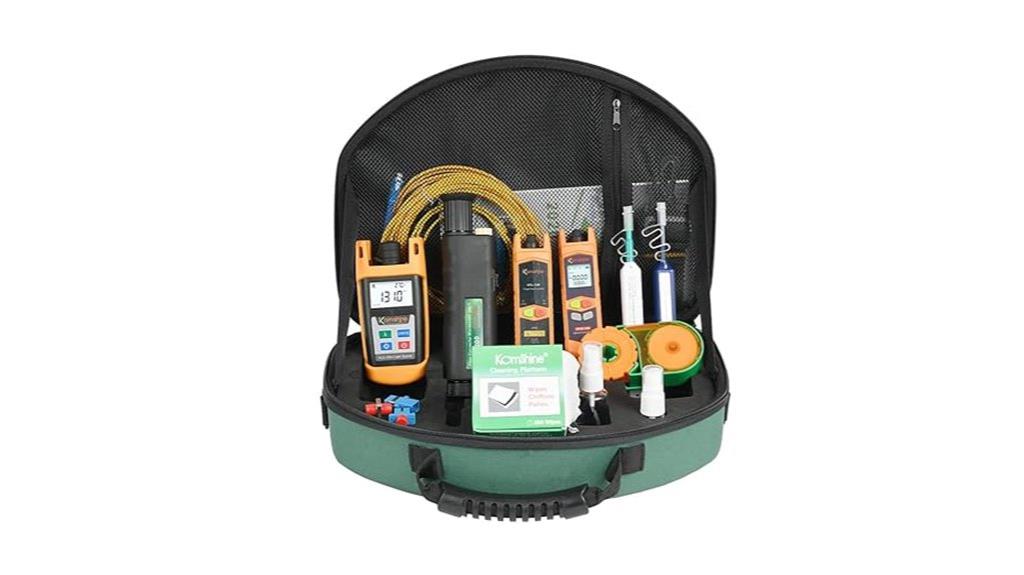
If you’re a fiber optic technician focused on FTTH installations and maintenance, the Komshine KLT-15D Fiber Optic FTTH Loss Toolkit stands out as an essential toolset. It includes a high-magnification microscope (200x) for detailed connector inspections, a versatile power meter (800-1700nm) with self-calibration, and a reliable light source at 1310/1550nm for accurate testing. The kit also features a mini VFL for locating faults and breaks, along with fiber cleaners compatible with various connector types. Compact and multifunctional, this toolkit streamlines diagnostics, ensuring precise measurements and peak connections for successful FTTH deployments.
Best For: fiber optic technicians performing FTTH installations, maintenance, and troubleshooting requiring precise testing and inspection tools.
Pros:
- Comprehensive toolkit with multiple essential fiber testing and inspection tools in one package
- Supports various connector types (SC, FC, ST, LC) for versatile application
- Compact, portable design facilitates on-site diagnostics and quick troubleshooting
Cons:
- May require additional training for optimal use of specialized testing equipment
- Cost could be higher compared to single-function devices
- Limited to fiber optic testing; not suitable for other cable or network types
BATOCA S4 Cordless Car Buffer Polisher Kit
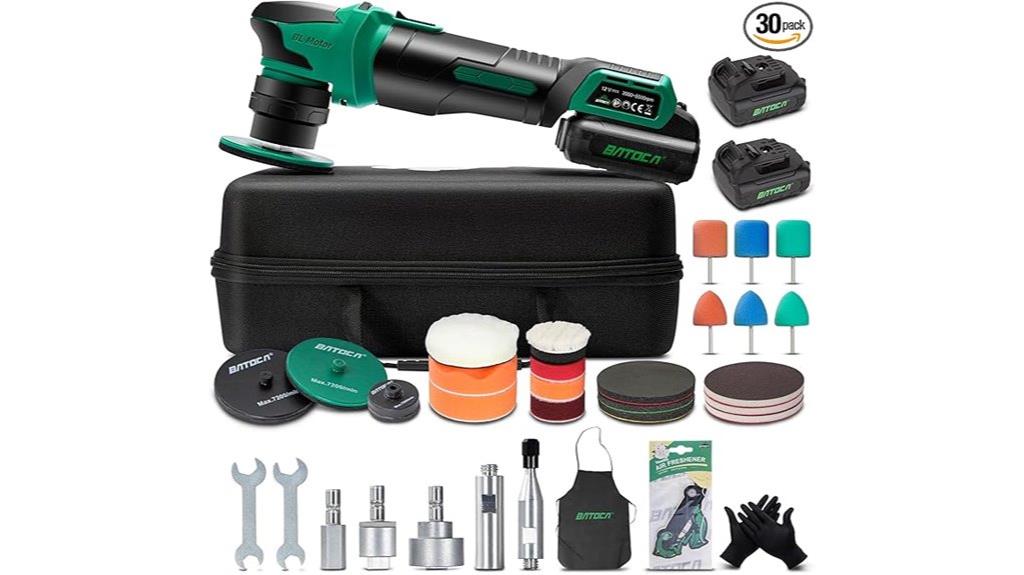
The BATOCA S4 Cordless Car Buffer Polisher Kit stands out as an ideal choice for detailers seeking versatility and efficiency, thanks to its quick-change head that switches tools in just five seconds without needing extra tools. Its compact, lightweight design, combined with a brushless motor, delivers longer runtime, more power, and a longer lifespan. Equipped with three adapters—rotary, orbital, and dual action—it handles various polishing tasks, from headlights to hard-to-reach areas. The included extension pole and small sponge enhance precision. With two batteries and fast swapping, this kit ensures continuous work, making it perfect for both professional and personal car detailing in 2025.
Best For: detailers and car enthusiasts seeking a versatile, cordless polisher for professional or personal vehicle detailing tasks.
Pros:
- Quick 5-second tool-free head change enhances workflow efficiency.
- Compact, lightweight design reduces user fatigue and allows for easy maneuverability.
- Multiple adapters and included accessories enable a variety of polishing applications, from headlights to hard-to-reach areas.
Cons:
- Requires two batteries for operation, which may be inconvenient if one battery is charging.
- Operating at 5500 RPM might be too high for very delicate surfaces without proper control.
- Slightly higher price point compared to basic corded polishers, reflecting its advanced features.
Maxshine 21mm Dual Action Polisher & 16oz AIO Polish

For auto detailers seeking a versatile, powerful polisher that balances performance and comfort, the Maxshine 21mm Dual Action Polisher with 16oz AIO Polish stands out. Its 21mm orbit and 6-speed control make it ideal for paint correction, swirl removal, and gloss enhancement. With a lightweight design, ergonomic handle, and minimal vibration, it’s comfortable even during long sessions. The 550W motor delivers high RPMs, ensuring efficient large-area polishing. Users appreciate its durability, balance, and value, often comparing it favorably to higher-end brands. Overall, it’s a reliable, effective tool for both professionals and hobbyists aiming for precision and efficiency.
Best For: auto detailers and hobbyists seeking a versatile, high-performance dual action polisher that offers excellent control, comfort, and value for paint correction and gloss enhancement.
Pros:
- Powerful 550W motor with high RPMs for efficient large-area polishing
- Ergonomic design with minimal vibration and comfortable grip for extended use
- Durable construction and positive user feedback, comparable to higher-end brands
Cons:
- Some users report minor issues with bearing quality and pad contact
- Grease inside may require replacement for smoother operation over time
- Occasional shipping damages or missing accessories, though support is responsive
7-Inch Pneumatic Sander Heavy Duty Wet Air Sander/Polisher

The 7-Inch Pneumatic Sander/Polisher stands out as an ideal tool for professionals and serious enthusiasts demanding heavy-duty performance. Weighing just 5.47 pounds, it offers powerful sanding and polishing with adjustable speeds up to 2500 RPM. Its high-quality aluminum shell ensures durability while remaining lightweight. The flip handle provides comfort for both left and right-handed use, and the vibration-free ball bearing design enhances control. Perfect for restoring paint, removing rust, or polishing fine scratches, this wet air sander operates quietly thanks to its muffled exhaust. It’s compatible with standard ¼” air hoses, making it versatile for various finishing tasks.
Best For: professionals and serious enthusiasts seeking a heavy-duty, lightweight pneumatic sander for polishing, sanding, rust removal, and finishing tasks.
Pros:
- Durable high-quality aluminum shell ensures long-lasting performance
- Lightweight design at 5.47 lbs reduces operator fatigue during extended use
- Adjustable speed up to 2500 RPM provides precise control for various applications
Cons:
- Requires a compatible standard ¼” air hose for operation
- Noise level may still be noticeable despite muffled exhaust, depending on environment
- May be too powerful for delicate or light-duty tasks that require gentler tools
Zenithra Fiber Optic Cleaner (5 Pack)
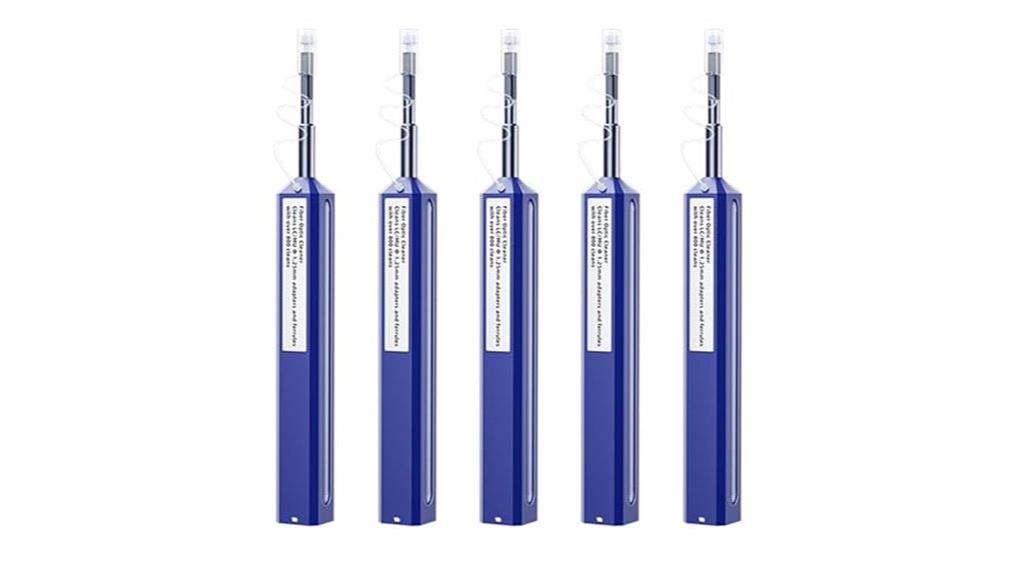
If you’re looking for a reliable, cost-effective solution to keep fiber optic connections clean, the Zenithra Fiber Optic Cleaner (5 Pack) delivers outstanding performance. Each pen features a simple push mechanism that automatically advances the cleaning tape for over 800 uses, ensuring long-term value. Its universal design suits various connectors like LC, MU, SC, FC, and ST, with both UPC and APC types. Made from anti-static materials with densely stranded microfibers, it effectively removes debris, water, and oil, achieving cleanliness levels of 95% or higher. Easy to handle and durable, this pack provides a practical, efficient way to maintain *ideal* fiber optic performance.
Best For: professionals and technicians seeking a reliable, cost-effective solution for maintaining clean fiber optic connections across various connector types.
Pros:
- Reusable with over 800 cleaning cycles per pen, offering excellent durability and value
- Compatible with multiple connector types including LC, MU, SC, FC, and ST, accommodating diverse setups
- Effective cleaning performance with over 95% dirt and oil removal, thanks to anti-static microfibers
Cons:
- May require careful handling to avoid damage to delicate connector ferrules during cleaning
- Limited to 5 pens per pack, which might necessitate additional purchases for extensive maintenance needs
- The push mechanism, while simple, may take some practice to operate smoothly for new users
Factors to Consider When Choosing a Fiber Optic Polishing Machine
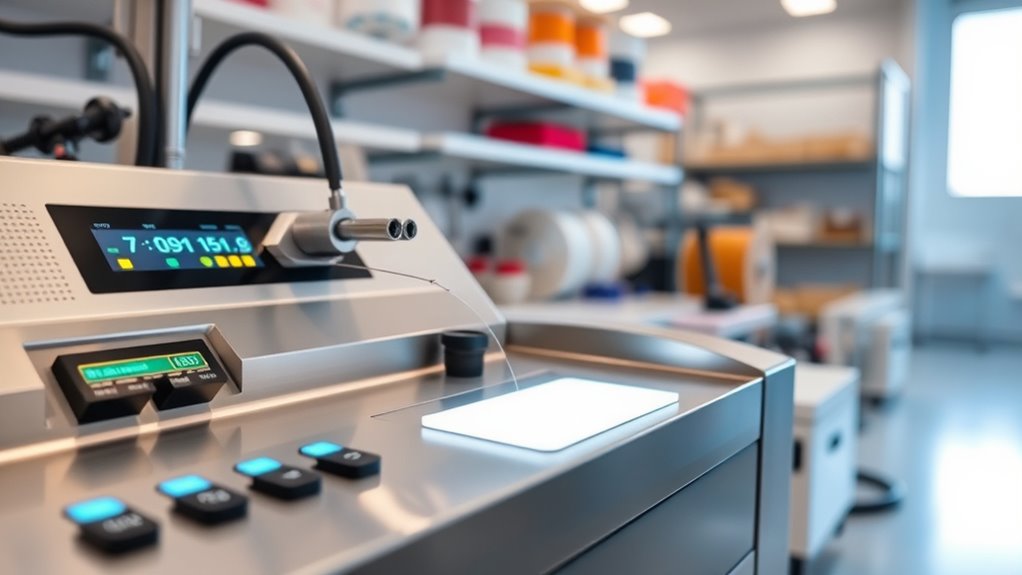
When choosing a fiber optic polishing machine, I focus on key factors like compatibility with different connectors and the polishing speed range. I also consider how easy it is to maintain, the available power sources, and the machine’s durability. These points help make sure I select a reliable tool that fits my specific needs.
Compatibility With Connectors
Choosing a fiber optic polishing machine requires ensuring it supports the connector types you use, such as SC, LC, FC, or ST, to avoid compatibility issues. I look for machines that can handle different ferrule sizes, like 1.25mm or 2.5mm, for versatility. It’s also essential to check if the machine can be fitted with adapters for connectors not natively supported, saving me from purchasing multiple tools. I verify that the fixtures and discs are compatible with various connector styles and materials, ensuring proper polishing. Additionally, I prefer machines with adjustable parameters or interchangeable parts, so I can easily adapt to different connector specifications and polishing needs. Compatibility is key to streamlining my workflow and achieving consistent, high-quality results.
Polishing Speed Range
The polishing speed range of a fiber optic polishing machine directly impacts the quality and efficiency of the polishing process. A wider range, typically from 1,750 to 8,500 RPM, allows for greater versatility, enabling gentle polishing of delicate fibers or aggressive removal on tougher materials. Precise control within this range ensures the surface finish is ideal without risking damage to the fiber or connector end face. Adjustable speeds are particularly important when working with different materials like ceramic, quartz, or metal, each requiring specific speeds for the best results. Machines with flexible speed settings improve overall efficiency by adapting to various tasks, ensuring consistent quality. Selecting a machine with the right speed range helps achieve precise, high-quality finishes while maintaining process speed and safety.
Ease of Maintenance
Selecting a fiber optic polishing machine with ease of maintenance can save you time and reduce frustration. I look for models with accessible parts and simple disassembly for quick cleaning and repairs. Clear maintenance instructions and support are essential, helping prevent mistakes that could shorten the machine’s lifespan. I also prioritize machines built with durable, high-quality components—like long-lasting planetary tracks and wear-resistant grinding discs—that minimize replacements. Modular designs or replaceable parts allow me to swap worn pads or polishing heads without hassle or specialized tools. Additionally, low-maintenance features such as self-lubricating bearings and sealed housings reduce the frequency of upkeep. Overall, an easy-to-maintain machine keeps operations smooth, minimizes downtime, and ensures consistent performance over time.
Power Source Options
When considering fiber optic polishing machines, the power source plays a significant role in how well the tool fits your work environment. Electric machines are reliable and offer consistent power, making them ideal for fixed workshops with easy access to outlets. Battery-powered options provide excellent portability, perfect for fieldwork, but their runtime depends on battery capacity, so planning for recharges is essential. Pneumatic machines utilize compressed air, making them well-suited for industrial settings with existing air supply systems, and they often deliver high power with less weight. Your choice impacts the machine’s weight, ease of use, and suitability for specific tasks. Consider your work location, mobility needs, and power availability to select the best option for your fiber optic polishing needs.
Durability and Build
Durability and build quality are crucial factors because they directly influence a fiber optic polishing machine’s longevity and consistent performance. I look for machines made from high-quality materials like 316 die steel and heat-treated components, which can withstand frequent use and tough environments. A robust build ensures precise alignment of internal parts, reducing vibration and wear over time, helping maintain high-quality polishing results. Corrosion-resistant features, such as stainless steel shells and coated moving parts, extend the machine’s lifespan, especially in industrial settings. Reinforced structural design minimizes mechanical failure risks, even during high-speed operations or when handling large batches of connectors. Investing in a well-built machine means fewer repairs and replacements, ultimately saving money and ensuring reliable operation over years.
Precision and Control
Achieving high-quality fiber polishing results depends heavily on precise control over speed and pressure during the process. I look for machines with adjustable speed settings, from low to high RPM, so I can customize the process for different fiber types and connector specs. Consistent rotation and orbital motion are essential to prevent uneven polishing, which can cause signal loss or connector failure. Fine-tuned control mechanisms, like variable speed triggers and feedback systems, help me achieve accuracy during delicate tasks. Digital displays or indicators are also critical, allowing me to monitor settings easily and guarantee repeatable results. Overall, a machine that offers precise, adjustable control helps me maintain the high quality and reliability needed in fiber optic connections.
Size and Portability
Choosing the right fiber optic polishing machine also means considering its size and portability. I look at the machine’s weight and dimensions to make sure it fits comfortably in my workspace and is easy to move between job sites. Smaller, lightweight units—typically under 10 pounds—are ideal for fieldwork, making setup quick and transport effortless. Features like built-in handles or carrying cases add to ease of mobility. A compact machine with a small footprint is perfect for tight spaces and fast setups. However, I also consider whether portability affects performance; I want a balance where the machine remains powerful enough for precise polishing while remaining easy to carry. Size and portability are key factors that influence efficiency and convenience on every job.
Cost and Budget
When selecting a fiber optic polishing machine, I need to carefully consider the cost and budget to guarantee I get a reliable tool without overspending. These machines vary from budget-friendly manual models to high-end automated systems, impacting the total investment. I should evaluate the initial purchase price alongside ongoing expenses like replacement parts, polishing discs, and consumables. Cheaper machines might have limited features, slower speeds, or less precision, which could reduce long-term efficiency. Budget constraints also influence choices regarding machine size, capacity, and compatibility with different connectors and fiber types. It’s essential to contemplate the total cost of ownership, including maintenance and potential upgrades, to make an economically sound decision that balances affordability with performance.
Frequently Asked Questions
What Is the Maximum Fiber Optic Cable Diameter Compatible With These Machines?
The maximum fiber optic cable diameter compatible with these machines is typically around 3mm. I’ve found that most modern polishing machines are designed to handle cable diameters up to this size, ensuring versatility for various fiber types. If you work with larger cables, you might need specialized equipment. Always check the manufacturer’s specifications to confirm compatibility before purchasing or operating a machine.
How Long Does a Typical Fiber Optic Polishing Process Take?
The typical fiber optic polishing process takes about 3 to 10 minutes per connector. I usually allocate enough time to guarantee a thorough, smooth finish without rushing. The exact time depends on the polishing machine, the type of connector, and the level of precision required. I find that patience and attention to detail lead to better performance and less need for re-polishing, ultimately saving time.
Are These Machines Suitable for Both Single-Mode and Multi-Mode Fibers?
Oh, absolutely! These machines are so versatile, they’ll make you think you’re switching between single-mode and multi-mode fibers like changing channels on a remote. In reality, they’re designed to handle both types with precision, saving you time and effort. So, whether you’re working with delicate single-mode fibers or bulkier multi-mode ones, you’ll find these machines up for the task, making your job easier and more efficient.
What Safety Features Are Included to Prevent Fiber Damage During Polishing?
I make sure the polishing machines I use have safety features like automatic fiber clamping and protective covers to prevent accidental damage. These features secure the fiber during polishing, reducing the chance of breakage or scratches. Additionally, they often include sensors that detect misalignment or excessive pressure, stopping the process immediately. These safety measures give me peace of mind, helping me achieve precise results without risking fiber damage.
Can These Polishing Machines Be Used in a Cleanroom Environment?
Absolutely, these polishing machines are designed with cleanroom compatibility in mind. I’ve seen models with sealed enclosures, HEPA filtration, and easy-to-clean surfaces that meet strict standards. Using them in a cleanroom environment ensures minimal contamination and exceptional performance. Just make sure to select a machine specifically rated for cleanroom use and follow proper protocols. Trust me, it’s a game-changer for maintaining quality and precision in sensitive environments.
Conclusion
Choosing the right fiber optic polishing machine is like finding the perfect brush for a masterpiece; it transforms your work from good to breathtaking. With the right tools, you’ll navigate the delicate art of polishing with confidence, turning precision into poetry. Remember, the right machine isn’t just equipment—it’s your trusted partner in crafting flawless connections that last a lifetime. Let your craftsmanship shine brighter than ever before.
